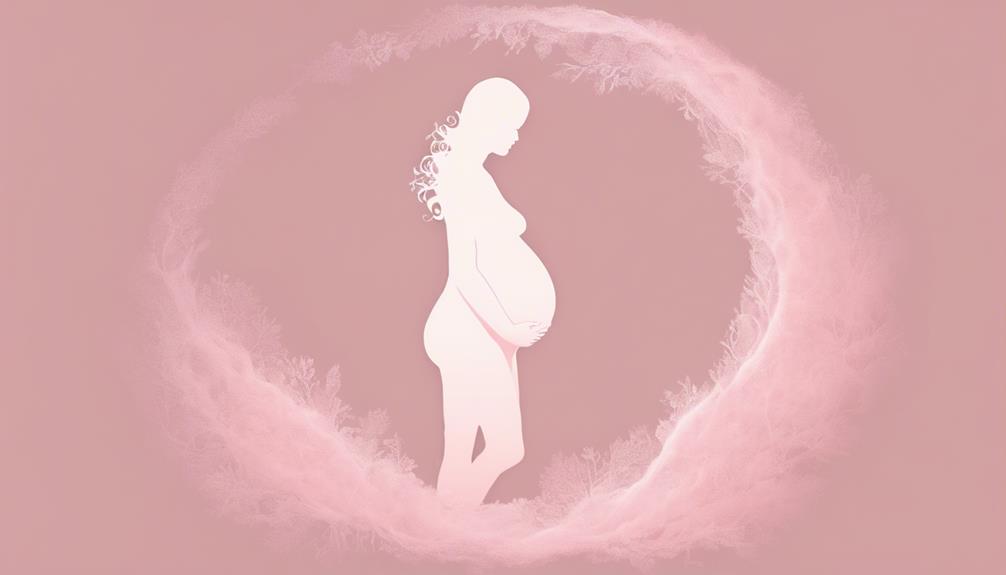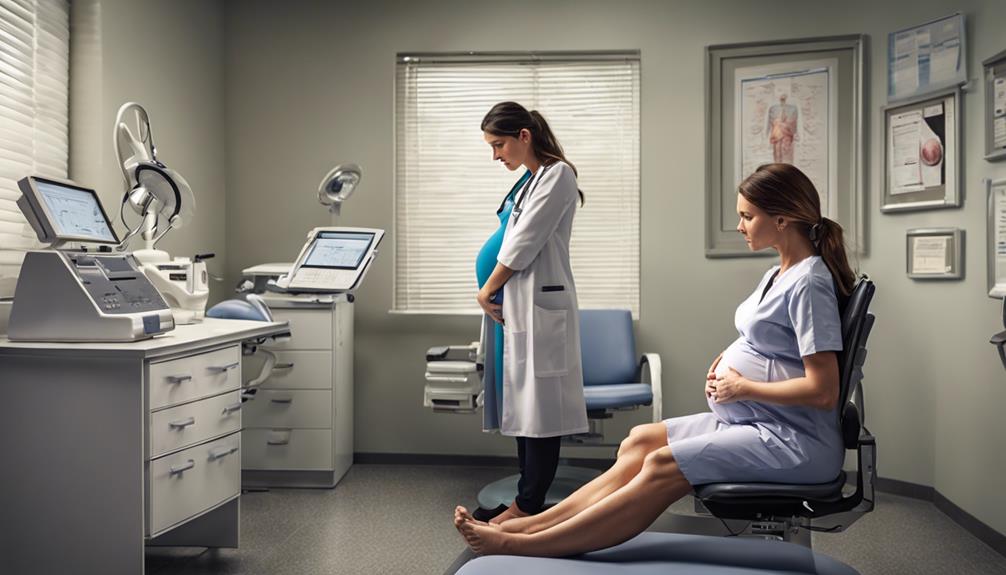Second Trimester
What Does Light Pink Discharge in the Second Trimester Mean?
A hint of light pink discharge in the second trimester may hold various meanings, prompting a deeper dive into potential causes and implications.

Similar to a soft wind that suggests an impending tempest, a light pink discharge during the second trimester could indicate several underlying issues. It might not always be a reason for urgent worry, but comprehending the causes is crucial for tranquility and comfort.
Let's explore the possible causes and implications of this common occurrence during pregnancy, shedding light on what to look out for and when to take further action for a healthier pregnancy journey.
Key Takeaways
- Light pink discharge in the second trimester is often due to hormonal changes or minor cervical irritation.
- Monitoring symptoms like cramping or abdominal pain is crucial for prompt evaluation.
- Seek medical advice for any concerning changes in color, consistency, or amount of discharge.
- Proper hygiene, regular prenatal check-ups, and addressing severe pain promptly are important for management.
Possible Causes of Light Pink Discharge
Light pink discharge in the second trimester can be attributed to various factors, including cervical irritation or sensitivity. Hormonal changes during pregnancy can also play a role in causing this type of discharge.
Understanding that light pink discharge may indicate minor bleeding from the cervix or vaginal walls, which can be concerning but often benign, is important. While in some cases, experiencing light pink discharge in the second trimester can be a normal part of pregnancy, it's important to remain vigilant and consult a healthcare provider if other concerning symptoms accompany this discharge.
Your healthcare provider can help determine the underlying cause of the discharge and provide appropriate guidance and care. Remember, open communication about any unusual symptoms during pregnancy is crucial for ensuring the well-being of both you and your baby.
Trust your instincts and seek professional advice whenever in doubt.
Normal Scenarios for Pink Discharge

In the second trimester of pregnancy, experiencing pink discharge can be considered normal in certain situations. Here are some normal scenarios for light pink discharge:
- Hormonal Changes: Hormonal fluctuations during pregnancy can lead to light pink discharge as the body adjusts to support the developing fetus.
- Vaginal Secretions: Increased vaginal secretions can sometimes appear as light pink discharge, especially when the cervix is more sensitive during pregnancy.
- Cervical Irritation: Activities like intercourse or vaginal exams may cause minor cervical irritation, resulting in light pink discharge that's usually harmless.
Remember that monitoring symptoms is important. While light pink discharge is often benign, any severe pain, heavy bleeding, or unusual symptoms should be promptly addressed by a healthcare provider.
Concerning Factors for Pink Discharge
Experiencing pink discharge in the second trimester alongside symptoms like cramping or abdominal pain can raise concerns about potential underlying issues that require prompt medical evaluation. Placental abnormalities such as previa, accreta, or abruption could be the cause, necessitating medical attention.
It's important not to ignore persistent or increasing light pink discharge during this stage of pregnancy. This type of discharge may also be a warning sign of preterm labor, which needs immediate attention to prevent complications. Any alteration in the color, consistency, or amount of discharge should be closely monitored and reported to a healthcare professional for further assessment.
When to Seek Medical Advice

Upon noticing any light pink discharge during the second trimester, it's essential to promptly seek medical advice if accompanied by cramping or pain. Here are three key points to keep in mind:
- Prompt Attention: Any light pink discharge coupled with cramping or pain warrants immediate medical evaluation to rule out any concerning issues.
- Monitoring Changes: It's important to monitor the light pink discharge regularly and keep track of any changes in color, consistency, or accompanying symptoms to discuss with your healthcare provider.
- Urgent Action: If the light pink discharge increases, becomes heavier, or is accompanied by other worrying signs such as fever or severe abdominal pain, seek immediate medical attention without delay.
Managing Light Pink Discharge
When managing light pink discharge in the second trimester, it's important to stay informed about proper hygiene practices and be vigilant about any changes in discharge consistency. Light pink discharge during this stage of pregnancy can be a result of hormonal changes and increased blood flow to the cervix. Monitoring the amount and texture of the discharge is essential to guarantee it stays within expected ranges. If you experience light pink discharge along with cramping or other concerning symptoms, contacting your healthcare provider is recommended.
Maintaining good vaginal hygiene practices is key when managing light pink discharge. Make sure you're using gentle, fragrance-free products and avoid douching to prevent any irritation. Regular prenatal check-ups play a crucial role in monitoring changes in light pink discharge and overall pregnancy progression. By staying informed about pregnancy changes and promptly addressing any unusual symptoms, you can navigate through the second trimester with confidence and peace of mind.
Frequently Asked Questions
Is Pink Discharge Normal in the Second Trimester of Pregnancy?
Pink discharge in the second trimester can be normal due to hormonal changes. It's often a mix of clear fluid and a bit of blood, resulting in a light pink color. If accompanied by concerning symptoms, consult a healthcare provider.
Is Light Spotting Normal in 2nd Trimester?
Spotting in the second trimester can be normal, often due to increased blood flow and hormonal changes. It's usually harmless but should be monitored. Stay in touch with healthcare providers to address any concerns promptly.
Is Pink Spotting Normal at 5 Weeks Pregnant?
Pink spotting at 5 weeks pregnant can be normal, often indicating implantation. We should observe any changes in amount or duration. If accompanied by severe pain or heavy bleeding, it's best to consult a healthcare provider.
What Color Discharge Is Normal During Second Trimester?
During the second trimester, normal discharge can range from clear to light pink due to hormonal shifts. It's typically not concerning unless accompanied by pain or heavy bleeding. Monitoring changes helps guarantee overall pregnancy health.
Conclusion
To sum up, light pink discharge in the second trimester of pregnancy can be a common occurrence with various causes. While usually not a cause for concern, it's essential to monitor any changes and consult a healthcare provider if needed.
Remember, staying vigilant and seeking medical advice promptly guarantees the safety and well-being of both mother and baby. Stay informed, stay safe!
Pamela is the voice behind our vibrant community, fostering connections and conversations among parents. Her expertise in community engagement and personal experiences as a parent fuel her passion for creating a supportive space for all. Pamela believes that community is crucial for navigating the complexities of parenting, offering a place for sharing, learning, and growing together.
Second Trimester
10 Tips to Alleviate Leg Pain During Pregnancy's Second Trimester
Worried about leg pain during pregnancy's second trimester?

Feeling leg pain in the second trimester of pregnancy can seem like a daunting obstacle, but don’t worry, we’ve put together 10 effective strategies to help alleviate your pain.
From simple lifestyle adjustments to targeted exercises, these strategies are designed to provide relief and support.
By implementing these suggestions, you can take proactive steps towards alleviating leg pain and enhancing your overall well-being during this critical stage of your pregnancy.
Key Takeaways
- Use cooling techniques and elevation to reduce swelling and pain in your legs.
- Ensure nutritional support and hydration for muscle function and circulation.
- Choose appropriate footwear with good arch support and flexibility for comfort.
- Prioritize rest, relaxation, and gentle exercises like prenatal yoga for leg pain relief.
Cooling Strategies
During the second trimester of pregnancy, we recommend incorporating cooling strategies to alleviate leg pain and discomfort. Pain and swelling in the legs can be particularly troublesome during this time, but simple remedies like using ice packs wrapped in a towel for around 10 minutes can offer quick relief. The cold sensation from the ice packs not only helps to relieve the pain but also reduces swelling, making you feel more comfortable.
Applying these cooling techniques can work wonders in relaxing your muscles and improving circulation, which ultimately eases the leg pain experienced during the second trimester. Whether it's taking a vital cold shower or bath, or directly targeting the affected areas with ice packs, incorporating these strategies into your daily routine can make a significant difference. By reducing inflammation and discomfort, you can enhance your overall sense of well-being during this important stage of pregnancy.
Elevating Legs

Elevating our legs on a pillow can be a simple yet effective way to improve blood circulation and reduce swelling during the second trimester of pregnancy. By raising our legs 6-12 inches above heart level, we can alleviate leg pain caused by increased pressure on blood vessels.
Placing pillows under our thighs, knees, and calves while elevating our legs not only enhances comfort but also promotes relaxation. Just dedicating 20 minutes to leg elevation can offer quick relief from sore and achy legs in the second trimester.
Additionally, elevating our legs can help reduce back pain associated with pregnancy by easing strain on the lower back muscles. So, whenever we feel the heaviness and discomfort creeping in, let's remember the power of elevating our legs to enhance blood flow, decrease swelling, and alleviate both leg and back pain.
Light Exercise Routine
When experiencing discomfort in our legs during pregnancy's second trimester, incorporating a light exercise routine can effectively improve circulation and alleviate muscle tension. Engaging in simple exercises like calf raises and gentle stretches not only helps prevent muscle tension but also promotes better blood flow, reducing leg pain. Standing exercises are particularly beneficial as they encourage improved circulation in the legs. These routines, when performed regularly, can also boost our mood and overall well-being during this critical time. However, it is essential to consult with our healthcare provider before starting any exercise regimen to make sure safety and effectiveness for both our well-being and the baby's. It's always wise to seek professional guidance and tailor the exercises to our individual needs. Our well-being is paramount, and with the right guidance, incorporating light exercise can be a nurturing and beneficial addition to our daily routine.
| Light Exercise Routine | Benefits |
|---|---|
| Calf raises | Prevents muscle tension |
| Gentle stretches | Improves circulation |
| Standing exercises | Promotes better blood flow |
| Consult healthcare provider | Ensures safety and effectiveness |
Leg Stretching Techniques

To enhance comfort and alleviate muscle tension in the legs during the second trimester of pregnancy, incorporating leg stretching techniques is highly beneficial. Stretching not only helps prevent leg cramps but also promotes flexibility and muscle strength, essential for pregnant women.
Calf stretches before bedtime can reduce the risk of nighttime leg cramps, providing much-needed relief. Hamstring stretches are also vital in improving flexibility, reducing discomfort, and supporting overall muscle health during pregnancy.
Ankle pumps, when done regularly, aid in enhancing circulation, which can alleviate swelling in the ankles—a common issue for pregnant women. Additionally, exercises like good mornings and wall squats with a ball can strengthen muscles in the lower back and legs, offering support and stability as your body undergoes changes.
Therapeutic Leg Massages
As we explore ways to alleviate leg pain during pregnancy's second trimester, let's now focus on the benefits of incorporating therapeutic leg massages into your self-care routine.
During pregnancy, leg pain and discomfort are common due to the extra weight and pressure on the lower body. A soothing massage can work wonders in increasing blood flow, reducing inflammation, and relaxing muscles in your legs. By targeting areas like the thighs, calves, and feet, you can effectively alleviate pain, swelling, and discomfort.
The gentle kneading and circular motions involved in a leg massage help release tension and promote relaxation, providing much-needed relief for expecting mothers.
You can easily perform leg massages at home using oils or creams, making it a cost-effective and convenient solution for managing leg pain during pregnancy. Incorporating regular leg massages into your self-care routine can significantly contribute to a more comfortable and enjoyable pregnancy experience.
Compression Wear Benefits

It's important to understand the benefits of wearing compression garments to alleviate leg pain and discomfort during pregnancy's second trimester. Here are some key advantages of using compression wear:
- Improved Circulation: Compression wear can enhance blood flow in the legs by gently applying pressure, reducing swelling and discomfort commonly experienced during pregnancy.
- Muscle Support: These garments provide essential support to muscles and joints, aiding in pain relief and promoting better posture to alleviate strain.
- Prevention of Varicose Veins: Wearing compression socks or stockings can help prevent the development of varicose veins and lessen the occurrence of leg cramps.
Proper Hydration Importance

Proper hydration plays a significant role in alleviating pregnancy-related leg pain and promoting overall well-being during the second trimester. Hydration is essential for preventing leg cramps and muscle spasms, which can be common discomforts during this stage of pregnancy.
By staying hydrated, you can help maintain ideal blood circulation, reducing the risk of experiencing debilitating leg pain. Dehydration, on the other hand, can worsen pregnancy-related leg pain, underscoring the importance of consuming an adequate amount of fluids daily.
Drinking water consistently throughout the day isn't only beneficial for alleviating discomfort but also for supporting joint health, muscle function, and overall pregnancy comfort. Ensuring proper hydration levels is a simple yet effective way to enhance your well-being and minimize the impact of leg pain during the second trimester of your pregnancy.
Nutritional Support Tips

Ensuring we get enough essential vitamins, such as calcium and magnesium, can greatly impact leg pain during pregnancy's second trimester.
It's vital to maintain proper hydration levels with water and electrolyte-rich beverages to support muscle function and prevent cramps.
Essential Vitamin Intake
For best leg health during pregnancy's second trimester, we emphasize the importance of maintaining essential vitamin intake. Ensuring you receive an adequate amount of vitamins can greatly help alleviate leg pain and discomfort.
Here are some essential vitamins to include in your diet:
- Vitamin D: Supports calcium absorption for strong bones and muscles.
- Vitamin B6: Reduces leg pain and cramps by improving nerve function.
- Vitamin E: Reduces inflammation and promotes circulation in the legs.
Hydration Importance
Maintaining adequate hydration levels during pregnancy's second trimester is important to minimize leg cramps and muscle spasms, supporting ideal circulation and reducing discomfort. Dehydration can worsen leg pain and lead to muscle cramps, especially during this stage. Drinking enough water is vital for muscle function and flexibility, aiding in alleviating leg pain. Hydration not only helps prevent discomfort but also supports the overall health and well-being of both the mother and the developing baby. Remember, staying hydrated is a simple yet powerful way to care for yourself and your little one. Check out the table below for some hydration tips:
| Hydration Tips | Benefits | Importance |
|---|---|---|
| Drink water regularly | Prevents dehydration | Essential |
| Include hydrating foods | Supports circulation | Helpful |
| Avoid excessive caffeine | Reduces muscle cramps | Recommended |
Footwear Considerations

When selecting footwear during pregnancy's second trimester, it's important to prioritize shoes with good arch support to alleviate leg pain and strain. As our bodies undergo changes, it's vital to provide adequate support for our legs and feet. Here are some considerations to keep in mind:
- Choose shoes with a wider toe box to accommodate any swelling or changes in foot size, ensuring comfort throughout the day.
- Opt for low-heeled shoes to help maintain balance and stability, reducing the risk of falls or discomfort.
- Consider slip-on or adjustable shoes that can easily adapt to any changes in foot size or swelling, providing flexibility as needed.
Rest and Relaxation Practices

As we focus on ways to alleviate leg pain during pregnancy's second trimester, incorporating rest and relaxation practices becomes paramount for maintaining comfort and well-being. Resting with legs elevated not only helps reduce swelling but also improves circulation, offering much-needed relief to our tired legs.
Taking short breaks throughout the day to elevate our legs can work wonders in alleviating leg pain and discomfort, giving us a moment of respite. Using pillows to support our legs while lying down or sitting can promote relaxation, easing the pressure on our lower body and providing a soothing sensation.
Additionally, practicing deep breathing exercises and mindfulness techniques can aid in relaxation and stress reduction, benefiting our overall well-being during this challenging time.
To further enhance our comfort, incorporating gentle stretching or prenatal yoga into our routine can help maintain flexibility, reduce muscle tension in the legs and back, and contribute to a sense of ease and well-being. Let's prioritize these practices to nurture ourselves and find relief from the strains of pregnancy.
Frequently Asked Questions
How Can I Stop My Legs From Aching During Pregnancy?
I acknowledge the discomfort of pregnancy leg pain. Stay hydrated, exercise, take vitamins, avoid crossing legs, and mind your posture. These simple steps can help ease the aches, keeping you more comfortable during this special time.
Why Do My Legs Hurt in My Second Trimester?
During our second trimester, leg pain can arise due to weight gain, altered posture, and increased pressure on joints caused by the growing baby. Hormonal changes and fluid retention add to discomfort. Gentle exercises, hydration, and supportive footwear can provide relief.
How Can I Stop Leg Cramps at Night During Pregnancy?
Understand how frustrating it is to battle leg cramps at night during pregnancy. Stretch before bed, avoid pointing toes, and hydrate well. If cramps strike, straighten your leg, flex your foot, and massage gently for relief.
Why Do My Legs Hurt at Night During Pregnancy?
Our legs hurt at night during pregnancy due to poor circulation, muscle fatigue, and pressure on nerves. Hormonal changes, weight gain, and fluid retention exacerbate discomfort. Engaging in exercises, stretching, and proper hydration can alleviate pain.
Conclusion
To wrap up, looking after our legs during pregnancy's second trimester is vital for our overall well-being. By following these 10 tips, we can help reduce discomfort and improve circulation. Remember to listen to your body, stay hydrated, and seek support from healthcare providers if needed.
Let's give our legs the love and attention they deserve during this special time.
Pamela is the voice behind our vibrant community, fostering connections and conversations among parents. Her expertise in community engagement and personal experiences as a parent fuel her passion for creating a supportive space for all. Pamela believes that community is crucial for navigating the complexities of parenting, offering a place for sharing, learning, and growing together.
Second Trimester
Why Am I Not Gaining Weight During Pregnancy Second Trimester?
Discover the surprising reasons behind stagnant weight gain in the second trimester of pregnancy, unraveling the mystery that may intrigue you further.

Navigating through the second trimester of pregnancy, we might be baffled by not seeing the scale move up even though there’s a growing baby inside us. This situation, while mystifying, highlights the importance of grasping the complex dynamics of different elements that affect our weight at this time.
From metabolic changes to hormonal fluctuations, the reasons behind stagnant weight may surprise you. Let's unravel the mystery together and explore potential insights that could shed light on this intriguing aspect of pregnancy.
Key Takeaways
- Morning sickness and food aversions can hinder weight gain
- Fast metabolism and underlying medical conditions play a role
- Stress and poor nutrition impact weight gain during second trimester
- Seeking guidance from healthcare providers is crucial for managing weight and nutrition
Possible Reasons for Lack of Weight Gain
During the second trimester of pregnancy, our bodies may experience various factors that can lead to inadequate weight gain. Factors such as morning sickness, food aversions, and a fast metabolism can all play a role in limiting weight gain during this important period. Additionally, underlying medical conditions, stress, and poor nutrition can also contribute to the struggle of gaining weight in the second trimester.
For some individuals, conditions like hyperemesis gravidarum, characterized by severe nausea and vomiting, can lead to significant weight loss rather than gain. It's important to be mindful of our caloric intake during this time, as insufficient energy consumption or challenges in maintaining a balanced diet can hinder proper weight gain.
Monitoring our weight gain and seeking guidance from healthcare providers are crucial steps to make sure both maternal and fetal health are prioritized throughout the second trimester of pregnancy.
Nutritional Tips for Second Trimester

Optimizing nutrition in the second trimester of pregnancy plays a pivotal role in supporting the healthy development of both the mother and the baby. Consuming nutrient-dense foods such as lean proteins, whole grains, fruits, and vegetables is essential for ideal fetal growth.
Including sources rich in folate, iron, calcium, and omega-3 fatty acids can greatly impact the baby's brain, bone, and overall health during this critical period. Adequate hydration is vital to maintain amniotic fluid levels, support blood volume expansion, and make sure proper nutrient transport to the baby.
Incorporating healthy fats from avocados, nuts, and seeds can help meet the increased energy needs of the second trimester while aiding in the baby's development. Seeking personalized guidance from healthcare providers or prenatal nutritionists for tailored dietary advice and meal planning can further enhance maternal and fetal health, ensuring a well-nourished and healthy pregnancy journey.
Impact of Inadequate Weight Gain
Insufficient weight gain in the second trimester of pregnancy poses significant risks to both maternal and fetal health, impacting the baby's growth and development outcomes. Low maternal weight gain during this essential period can lead to complications in fetal development, increasing the risk of intrauterine growth retardation (IUGR). Monitoring weight gain is essential to identify such risks early and take necessary actions promptly. Proper weight management practices in the second trimester play a critical role in ensuring ideal fetal growth and development.
| Impact of Inadequate Weight Gain | Risk Factors |
|---|---|
| Increased risk of IUGR | Low maternal weight gain |
| Complications for fetal development | Insufficient weight gain |
| Adverse effects on baby's growth | |
| Health outcomes affected |
Being mindful of weight gain in the second trimester is critical as it directly influences the health of both the mother and the baby. Proper monitoring and management can mitigate the risks associated with inadequate weight gain, promoting a healthier pregnancy journey.
Seeking Medical Advice

Seeking medical advice in the second trimester of pregnancy is important for addressing challenges related to weight gain and ensuring the well-being of both the mother and the baby. If you're experiencing difficulties with weight gain during this important period, consulting a healthcare provider is essential. Your healthcare professional can help identify the underlying reasons for inadequate weight gain and provide personalized solutions tailored to your specific needs. They can offer valuable guidance on nutrition, recommend beneficial lifestyle changes, and discuss potential interventions to support healthy weight gain throughout your pregnancy.
Regular monitoring and follow-up appointments with your doctor are crucial for addressing any weight concerns promptly. By seeking medical advice promptly, you can effectively manage any potential risks associated with insufficient weight gain during the second trimester. Remember, your healthcare provider is there to support you every step of the way, ensuring both your health and the health of your baby are prioritized during this important time.
Healthy Weight Management Strategies
Moving forward from discussing seeking medical advice during the second trimester of pregnancy, a significant aspect to focus on is implementing effective Healthy Weight Management Strategies. During this pivotal period, factors such as increased energy expenditure, baby's growth, and changes in metabolism can influence weight gain.
To maintain a healthy weight, it's essential to consume nutrient-dense foods, stay hydrated, and engage in moderate physical activity. Adequate weight gain in the second trimester not only supports the baby's growth but also guarantees proper nutrition and helps prevent complications like intrauterine growth retardation. Consulting healthcare providers for personalized guidance on weight gain, monitoring fetal growth, and addressing any concerns is crucial.
Balancing caloric intake, incorporating a variety of food groups, and managing stress levels are key components of maintaining a healthy weight during the second trimester of pregnancy. Prioritizing these strategies can support both maternal and fetal well-being.
Frequently Asked Questions
Is It Normal to Not Gain Weight in 2nd Trimester?
It's common to experience minimal weight gain or even weight loss during the second trimester of pregnancy. Factors like morning sickness and changes in appetite can contribute. Monitoring fetal growth through ultrasound can provide reassurance.
How Much Weight Should You Gain 2nd Trimester?
We should aim to gain weight gradually in the second trimester to support our baby's growth. Recommendations vary based on pre-pregnancy BMI. It's important to consult our healthcare provider for personalized guidance on healthy weight gain during pregnancy.
Is It OK if I Am Not Gaining Weight During Pregnancy?
It's concerning if we're not gaining weight during pregnancy, impacting our baby's growth. Monitoring weight gain is crucial for a healthy pregnancy. Consulting healthcare providers helps address any issues promptly, ensuring peak outcomes for both of us.
How Can I Gain Weight in My Second Trimester?
To gain weight in the second trimester, we focus on nutrient-dense foods, healthy fats, hydration, and approved physical activity. Consulting a prenatal nutritionist can help create a personalized meal plan supporting healthy weight gain.
Conclusion
Despite our efforts to gain weight during the second trimester of pregnancy, it seems like our bodies have other plans. While it may be frustrating, remember that the most important thing is the health and well-being of both ourselves and our baby.
Trust in the guidance of healthcare providers, focus on nourishing foods, and stay active. Sometimes, the scale doesn't tell the whole story, but our bodies know what they need.
Pamela is the voice behind our vibrant community, fostering connections and conversations among parents. Her expertise in community engagement and personal experiences as a parent fuel her passion for creating a supportive space for all. Pamela believes that community is crucial for navigating the complexities of parenting, offering a place for sharing, learning, and growing together.
Second Trimester
10 Tips to Combat Dizziness in the Second Trimester
Curious about how to conquer dizziness in the second trimester?

In managing dizziness during the second trimester, making minor changes such as rising slowly and steering clear of abrupt actions can be remarkably effective.
But what about those moments when dizziness seems persistent despite these efforts?
Our list of ten practical tips offers a complete approach to tackle this common pregnancy woe.
From hydration to stress management, each tip plays an important role in maintaining balance during this important stage of pregnancy.
Key Takeaways
- Stay hydrated with water and electrolyte-rich beverages to regulate blood pressure and prevent dizziness.
- Manage stress through deep breathing and rest to support overall well-being during the second trimester.
- Engage in safe pregnancy exercises like walking and prenatal yoga to improve circulation and reduce dizziness.
- Monitor blood sugar levels regularly, and pay attention to food choices to manage levels and prevent dizziness.
Stay Hydrated
Staying hydrated during the second trimester is essential for combating dizziness caused by hormonal changes and increased blood volume. Dehydration can exacerbate feelings of lightheadedness, so ensuring adequate fluid intake is vital. Drinking 8-10 glasses of water daily can help regulate blood pressure and circulation, supporting your body as it adapts to the changes of pregnancy. Additionally, electrolyte-rich beverages such as coconut water or sports drinks can aid in replenishing lost fluids and essential minerals, further alleviating dizziness.
Incorporating hydrating foods into your diet, like watermelon, cucumbers, and oranges, can also play a significant role in maintaining hydration levels. These foods not only provide water content but also offer essential nutrients to support your overall well-being during this critical stage of pregnancy. By prioritizing hydration through both fluids and hydrating foods, you can help reduce the frequency and intensity of dizziness in the second trimester, promoting a more comfortable pregnancy experience.
Maintain Balanced Diet

To maintain a balanced diet during the second trimester, focus on incorporating a variety of nutrient-rich foods essential for supporting your overall health and preventing dizziness. Include iron-rich foods like lean meats, spinach, and lentils to prevent anemia-related dizziness. Make sure you incorporate sources of vitamin B12 such as eggs, dairy, and fortified cereals to support peak nerve function and energy levels.
Folic acid found in foods like leafy greens, citrus fruits, and beans can aid in red blood cell production, helping to prevent dizziness. Stay hydrated by drinking water and consuming hydrating foods like watermelon, cucumbers, and soups to maintain blood volume and prevent dehydration-induced dizziness.
Avoid skipping meals and choose balanced, nutrient-dense snacks to stabilize blood sugar levels and prevent dizziness associated with low blood sugar. By prioritizing these dietary elements, you can help combat dizziness and promote a healthier pregnancy journey.
Manage Stress Levels
Managing stress levels during the second trimester is essential for promoting overall well-being and enhancing the pregnancy journey. With the challenges that pregnancy can bring, it's vital to find ways to relax and unwind.
Deep breathing exercises are a simple yet effective method to lower stress levels and promote a sense of calm. Consider incorporating prenatal yoga or gentle stretching into your routine to release tension in your body and mind. Adequate rest is also paramount – make sure to prioritize sleep to rejuvenate yourself.
Exploring mindfulness techniques or meditation can help enhance your emotional well-being and better cope with the daily stresses you may encounter.
Don't hesitate to seek support from loved ones, healthcare providers, or pregnancy support groups. Sharing your concerns and feelings can alleviate stress and provide you with the reassurance you need. Remember, managing stress not only benefits you but can also help prevent issues like low blood pressure. Prioritize your well-being during this special time.
Avoid Sudden Movements

When it comes to combating dizziness in the second trimester, we comprehend the importance of avoiding sudden movements.
Gentle exercises and staying hydrated can positively impact blood pressure stability and reduce the risk of feeling lightheaded.
Gentle Exercise Benefits
Incorporating gentle exercises into your routine, such as prenatal yoga or swimming, can greatly enhance circulation and reduce dizziness during the second trimester. Here are some tips to help you enjoy the benefits of gentle exercise:
- Engage in low-impact activities like walking or stationary cycling.
- Focus on controlled movements to maintain balance and prevent sudden drops in blood pressure.
- Prioritize relaxation and gentle stretching to alleviate dizziness symptoms.
- Consult with a healthcare provider or prenatal fitness specialist for tailored exercise recommendations.
- Avoid sudden movements or rapid changes in position during your workout routine.
Stay Hydrated Always
Staying consistently hydrated throughout the day is essential to help combat dizziness in the second trimester, particularly by avoiding sudden movements that can trigger lightheadedness. Dehydration can exacerbate dizziness, making it critical to drink at least 8-10 glasses of water daily.
Changes in blood pressure during pregnancy can lead to feeling lightheaded, so it's important to sip water regularly and maintain hydration levels. Proper hydration supports circulation, helping regulate your body temperature and reducing the risk of dizziness.
Remember to avoid quick changes from sitting to standing; instead, take your time to adjust slowly. By prioritizing hydration and being mindful of sudden movements, you can better manage dizziness and feel more comfortable during this stage of pregnancy.
Practice Gentle Exercise

Let's focus on incorporating safe pregnancy workouts that include low-impact movement routines and balance and stability exercises. These gentle forms of exercise can help improve circulation, maintain fitness, and reduce dizziness in the second trimester.
Consulting with a healthcare provider to customize an exercise plan to fit your specific needs and pregnancy stage is essential for a safe and effective routine.
Safe Pregnancy Workouts
For a gentle yet effective approach to combat dizziness during the second trimester, consider incorporating safe pregnancy workouts such as walking, prenatal yoga, or swimming into your routine. These workouts help improve circulation, reduce stress, and maintain overall fitness levels without exerting too much pressure on the body. Prenatal workouts can enhance muscle tone, flexibility, and endurance, contributing to a healthier pregnancy experience.
Consult with a healthcare provider or a prenatal fitness expert to tailor a workout routine that suits your specific needs and limitations during pregnancy. Regular, moderate physical activity can also help alleviate common discomforts like back pain and fatigue while promoting better sleep and mental well-being.
- Incorporate walking, prenatal yoga, or swimming into your routine.
- Improve circulation, reduce stress, and maintain fitness levels.
- Enhance muscle tone, flexibility, and endurance.
- Consult with a healthcare provider for a tailored workout plan.
- Alleviate back pain, fatigue, and promote better sleep.
Low-Impact Movement Routines
Engage in gentle low-impact exercises like prenatal yoga or swimming to effectively improve circulation and reduce dizziness experienced during the second trimester of pregnancy. These gentle movement routines promote blood flow, relieving pressure on blood vessels and enhancing overall well-being. Prenatal yoga focuses on gentle stretching and breathing techniques, while swimming provides a full-body workout without strain. Here is a table highlighting the benefits of these low-impact exercises:
| Exercise Type | Benefits |
|---|---|
| Prenatal Yoga | Improves flexibility and reduces stress |
| Swimming | Enhances cardiovascular health |
| Walking | Promotes circulation and boosts energy |
| Pilates | Strengthens core muscles |
| Stationary Bike | Increases endurance and supports joints |
Prioritize your comfort and safety by consulting with healthcare providers or prenatal fitness specialists for personalized exercise recommendations.
Balance and Stability Exercises
To enhance coordination and prevent falls during the second trimester, consider incorporating balance and stability exercises into your routine. Engaging in gentle exercises like yoga, tai chi, or Pilates can help improve core strength and stability.
Here are some tips to help you enjoy your balance and stability exercises:
- Try practicing yoga poses that focus on balance and strength.
- Incorporate tai chi movements into your daily routine to promote stability.
- Consider joining a Pilates class tailored for pregnant women to enhance core strength.
- Practice standing on one leg for short intervals to improve balance.
- Focus on controlled movements to build stability and reduce the risk of falls.
Get Sufficient Rest

Ensuring you get sufficient rest during your second trimester is important for supporting your body and promoting overall well-being. As dizziness and fatigue can often be challenging during this time, aiming for 7-9 hours of quality sleep each night is essential.
Don't hesitate to incorporate short naps into your daily routine to combat fatigue and boost your well-being. Using pillows for support while resting can help alleviate any discomfort, making sleep more comfortable.
Additionally, developing a calming bedtime routine can signal to your body that it's time to unwind, promoting better sleep quality. Prioritizing relaxation techniques such as deep breathing or gentle stretches can further enhance restfulness and reduce stress levels.
Monitor Blood Sugar Levels

Monitoring our blood sugar levels is key to managing dizziness during the second trimester. Fluctuations in these levels can directly impact how we feel.
Sugar Level Monitoring
During pregnancy, maintaining stable blood sugar levels becomes important in preventing dizziness, particularly when faced with morning sickness or gestational diabetes. Here are some tips to help you monitor your sugar levels effectively:
- Regularly check your blood sugar levels to catch any fluctuations early.
- Pay attention to how your body responds to different foods to manage levels.
- Stay hydrated to support stable blood sugar levels.
- Have small, frequent meals to prevent drastic spikes or drops.
- Keep a journal to track your readings and identify patterns that could be causing dizziness.
Importance of Monitoring
Exploring the second trimester of pregnancy calls for a mindful approach towards stabilizing blood sugar levels to combat potential dizziness episodes. During this stage, hormonal changes can lead to fluctuations in blood sugar levels, triggering feelings of dizziness.
Monitoring blood sugar levels is vital to maintaining stability and preventing low blood sugar-induced dizziness. Regular monitoring, coupled with a diet rich in balanced nutrition, can help manage blood sugar levels effectively.
Symptoms like dizziness, shakiness, and headaches may signal low blood sugar, especially in the second trimester. Adequate snacking on fruits or candies can aid in boosting blood sugar levels and alleviating dizziness.
Stay vigilant in monitoring your blood sugar levels to guarantee a stable and healthy pregnancy.
Managing Blood Sugar
To effectively manage dizziness during the second trimester, consistent monitoring of blood sugar levels is essential. Fluctuations in blood sugar can greatly impact how you feel, so it's important to keep them stable.
Here are some tips to help you manage your blood sugar effectively:
- Monitor blood sugar levels regularly to track any changes.
- High blood sugar can lead to dizziness, while low levels can cause faintness.
- Work closely with your healthcare provider to establish a monitoring routine.
- Make necessary dietary adjustments to keep blood sugar levels balanced.
- Proper blood sugar management can alleviate dizziness and promote well-being for both you and your baby.
Wear Supportive Footwear

When seeking relief from dizziness in the second trimester, prioritizing supportive footwear becomes essential for maintaining balance and comfort throughout the day. Choosing shoes with good arch support not only reduces strain on your feet but also improves circulation, helping to combat dizziness. Opt for low-heeled, comfortable footwear to enhance stability and prevent any foot or ankle discomfort that may contribute to feelings of lightheadedness. Avoiding high heels or unsupportive shoes is pivotal to guarantee your safety and well-being during this sensitive time. Consider incorporating orthotic inserts or insoles for that extra layer of support and cushioning, especially when you know you'll be on your feet for extended periods. Remember, the right footwear is not just about style but about your overall health and comfort. Here's a helpful table to guide you in selecting the best supportive footwear:
| Feature | Importance |
|---|---|
| Arch Support | Reduces strain on feet and aids circulation |
| Low-Heeled | Enhances stability and balance |
| Comfortable | Prevents foot discomfort and dizziness |
Consider Acupuncture or Acupressure

Considering acupuncture or acupressure during the second trimester can be a beneficial option for alleviating dizziness and enhancing overall well-being in pregnancy. Acupuncture involves gentle insertion of thin needles into specific body points, while acupressure applies pressure to these points to address various pregnancy discomforts. Here are some key points to help you understand how acupuncture and acupressure can aid in managing dizziness and promoting wellness during this vital phase:
- Acupuncture regulates blood flow, reducing stress and hormonal imbalances that contribute to dizziness.
- Acupressure targets specific points like the wrist or between eyebrows to relieve dizziness and nausea.
- Acupressure bands like Sea-Bands offer continuous pressure to alleviate symptoms conveniently.
- Research supports that these therapies can enhance circulation, reduce dizziness, and induce relaxation in pregnant individuals.
- Both acupuncture and acupressure are safe complementary therapies that can complement traditional medical care during pregnancy, providing natural relief from various discomforts.
Seek Medical Advice

If you're experiencing persistent or severe dizziness during the second trimester, consulting with your healthcare provider is vital for personalized guidance and appropriate management strategies. Your healthcare provider can assess the underlying causes of your dizziness and recommend tailored management strategies to help you cope better.
It's important to seek medical advice if dizziness starts impacting your daily activities or if you notice any concerning symptoms accompanying it. Your healthcare provider can offer personalized guidance on how to manage your dizziness based on your specific health needs, ensuring you receive the best care possible.
Frequently Asked Questions
How Do You Get Rid of Dizziness in the Second Trimester of Pregnancy?
To alleviate dizziness in the second trimester, we recommend staying hydrated, avoiding sudden movements, eating small, frequent meals, engaging in gentle exercises, and considering support stockings for improved circulation. These practices can help manage dizziness during pregnancy.
Is Dizziness Normal During Second Pregnancy?
Absolutely, dizziness during the second pregnancy is quite common due to various factors like hormonal changes and increased blood volume. It's a rollercoaster ride, but staying hydrated, eating well, and staying active are key!
Is Extreme Dizziness Normal in Late Pregnancy?
Yes, extreme dizziness in late pregnancy can signal various issues like hormonal shifts, blood volume changes, or underlying conditions. It's important to seek medical advice if severe dizziness persists. Stay hydrated, eat well, and move slowly to manage symptoms.
What Gets Rid of Dizziness Fast?
When we feel dizzy, we find relief by hydrating well, eating balanced meals, moving slowly, and doing light exercises. These simple steps help us combat dizziness fast and keep us feeling better during the second trimester.
Conclusion
In our journey through the second trimester, we've learned how to combat dizziness with simple yet effective tips. By staying hydrated, eating well, and practicing gentle exercise, we can navigate this phase with confidence.
Remember, your health and well-being are top priorities, so don't hesitate to seek medical advice if needed.
Let's embrace each day with strength and resilience, knowing that we've the tools to overcome any challenges that come our way.
Pamela is the voice behind our vibrant community, fostering connections and conversations among parents. Her expertise in community engagement and personal experiences as a parent fuel her passion for creating a supportive space for all. Pamela believes that community is crucial for navigating the complexities of parenting, offering a place for sharing, learning, and growing together.
-

 Third Trimester4 weeks ago
Third Trimester4 weeks agoSafe Third Trimester Exercise Guide for Moms-to-Be
-

 Third Trimester1 month ago
Third Trimester1 month agoManaging Nausea in the Third Trimester: A How-To Guide
-

 Breastfeeding/Formula Feeding2 weeks ago
Breastfeeding/Formula Feeding2 weeks agoOvercoming Formula Feeding Guilt: 10 Ways to Feel Empowered
-

 Breastfeeding/Formula Feeding2 months ago
Breastfeeding/Formula Feeding2 months agoDairy-Free Breastfeeding Diet: A Comprehensive Guide
-

 Newborn Care4 weeks ago
Newborn Care4 weeks agoEssential Newborn Care: A How-To Guide for Parents
-

 First Trimester2 weeks ago
First Trimester2 weeks agoDramamine Use in Pregnancy: First Trimester Guide
-

 Third Trimester2 months ago
Third Trimester2 months agoWhat Causes Low Platelets in Pregnancy During the Third Trimester?
-

 Third Trimester2 months ago
Third Trimester2 months agoSigns of Baby Distress in Third Trimester: What to Watch For










